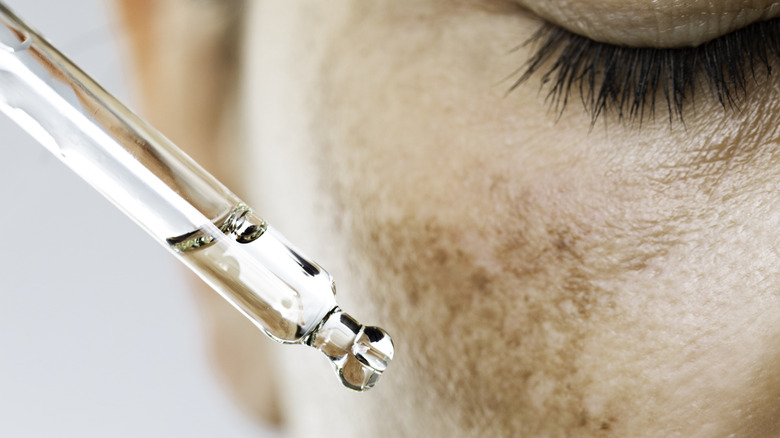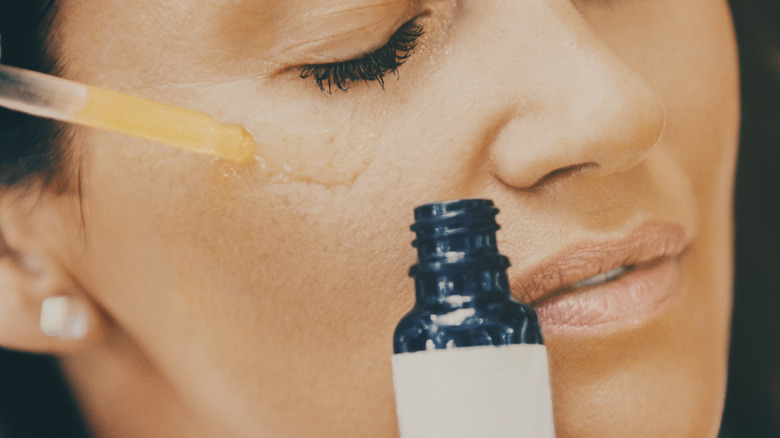What Is Matrixyl 3000 & What Can It Do For Your Skin? The Skincare Serum Explained
We may receive a commission on purchases made from links.
With anti-aging options proliferating, consumers have many options to choose from. The search for an anti-aging skincare product usually starts with ingredients that boost collagen, a naturally occurring protein that supports connective tissues in the body to keep the skin, tendons, and joints stretchy and strong. Our body gradually loses the ability to naturally manufacture collagen as we age, causing the skin to sag and aging lines to become more pronounced. To plump the skin and fill in the wrinkles, we need a steady supply of collagen into our skin. Matrixyl 3000, a powerful collagen booster and the newest superstar in the anti-aging aisle, can deliver that.
Matrixyl 3000 is a blend of peptides, a naturally occurring substance in the body and a common ingredient in many skincare products. "Peptides are strings of amino acids, which are the building blocks that make up proteins in our body, including collagen in the skin," dermatologist and author Dr. Whitney Bowe tells Dermstore. "Without these proteins, we will see wrinkles, brittle nails and dry hair that's prone to breakage." Peptides are crucial to our skin health, and Matrixyl 3000 is a rich source. This skincare serum is slated to substitute retinol, a well-established holy grail of anti-aging skincare.
Here's what to know about Matrixyl 3000, a peptide-enriched ingredient that deserves to be your next go-to for all your fine lines and wrinkles.
What is Matrixyl 3000?
Developed by the French Sederma corporation, Matrixyl 3000 is a trademarked mix made up of palmitoyl tripeptide-1 and palmitoyl tetrapeptide-7. Between these peptides, the former is a synthetic fatty acid polypeptide known for its ability to diminish visible skin damage. The latter is a synthetic peptide comprised of four amino acids and palmitic acid that assist in cell functions and restore firmness to the skin.
These two peptides are also known as matrikines, or messenger peptides, because they are responsible for instructing skin cells to reorganize the extracellular matrix, the largest part of the dermal skin layer, to repair skin damage and make the skin look younger.
This synergistic blend regulates cellular activities and boosts protein synthesis in the skin's extracellular matrix, stimulating collagen and protein production while slowing down cell deterioration. The remaining Matrixyl™ 3000 blend contains glycerin, water, butylene glycol, carbomer, and polysorbate 20.
What Matrixyl 3000 can do for the skin
Studies have shown that Matrixyl 3000 can take years off your face. Apart from smoothing the skin texture, Matrixyl™ 3000 can also improve skin tone and elasticity to diminish the appearance of aging lines. Collagen and elastin are essential to your skin's youthfulness. Since the peptides used in Matrixyl 3000 are messenger peptides, they can instruct skin cells to produce more collagen and elastin, which is exactly what your skin needs. The more collagen and elastin in your skin, the smoother and firmer it feels and looks.
Inflammation is a major cause of aging spots and acne; peptide-based Matrixyl 3000 can fix that. This product can help reduce inflammatory response, curtailing inflammatory damage and destruction of the skin's collagen and elastin to prevent your skin from sagging and promote a younger appearance. Some skincare authorities claim that Matrixyl 3000 can also increase the levels of hyaluronic acid in your skin, which helps to strengthen your skin barrier's defense against environmental aggressors and boost its moisture retention capability. For this reason, Matrixyl 3000 is also a big boon to those with acne or acne scars.
Potential side effects of Matrixyl 3000
Fortunately, Matrixyl 3000 is safe to use daily and is well-tolerated by most skin types. You should be careful when using the product with other active ingredients in your skincare routine because peptides and certain actives cancel each other out.
For instance, acids such as vitamin C, salicylic acid, and glycolic acid, as well as potent exfoliants like AHA and BHA, might compromise the efficacy of Matrixyl 3000 and trigger adverse reactions to the skin's surface. To make the most of the product and avoid irritation, don't use Matrixyl 3000 with these acid actives.
However, if you must use vitamin C on a daily basis and you don't want to skip the peptide complex either, give your skin at least 30 minutes of wait time between applications so the first product has time to settle into the skin. Another way to go about it is to use a vitamin C serum with a low concentration and see how you react to the layering. If your skin can tolerate it, you can slowly work your way up.
How to use Matrixyl 3000
Matrixyl 3000 is often found in the serum form, which should be applied on damp skin after a face wash and before a moisturizer. The method for applying Matrixyl to your skin is the same as using other serums: Dispense a little amount of serum onto your fingertips, gently apply it in circular motions to your face and neck, and pat your skin to boost the product's penetration.
According to Dermatologist Dr. Ava Shamban, Matrixyl 3000 can be used twice a day in your daytime and nighttime routine. "It's not counterintuitive with the sun and does not have any reactivity factors that relegate the time it should be applied," Dr. Shamban tells TZR. Nonetheless, given the skin-repairing function of this peptide complex, it might be more beneficial to use it before bedtime, Dr. Shamban notes.
In terms of efficacy, you can expect to see progress after about two weeks of product usage. Furthermore, studies have shown that using Matrixyl 3000 twice a day for two months decreases the area of deep wrinkles by 45%.
Is Matrixyl 3000 better than retinol?
Since Matrixyl 3000 doesn't increase your skin's sensitivity to UV rays or put your skin at risk of side effects like retinol, it's often recommended as a retinol alternative for sensitive skin.
Nonetheless, retinol and Matrixyl 3000 don't cancel each other out. If your skin is well-tolerated to retinol, you can use them together to reach your anti-aging skin goals faster. Retinol and Matrixyl 3000 might work differently, but they both work well to facilitate collagen production, reduce the appearance of fine lines and give the skin a fresher appearance. But to minimize adverse reactions, you should apply these two powerhouse ingredients in separate routines.
Aside from retinol, you can combine Matrixyl 3000 with other hydrating ingredients, such as hyaluronic acid, to boost your skin's hydration and elasticity. Niacinamide, a collagen booster, can also be combined with Matrixyl 3000 to improve hyperpigmentation and fortify the skin's barrier.
Overall, the greatness of Matrixyl 3000 lies in its ability to command the skin to produce more collagen and elastin than it normally would, which results in smoother, firmer skin. If you're on the quest for the next big ingredient to introduce into your anti-aging kit, Matrixyl 3000 might just be what the doctor ordered.





